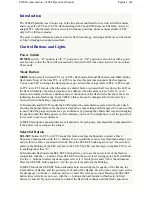
V1.02
Thom Hogan’s Complete Guide to the Nikon D300
Page 611
involves pressing the flash unit’s Direction pad in the
direction of the + and – symbols while in a TTL flash mode.
For the D300 body, that means holding down the Flash
Options button and rotating the Front Command dial.
Flash exposure compensation isn’t as straightforward as you
might think:
• Balanced Fill-Flash gets in the way.
If the camera is set to
use
TTL BL
(the default), you aren’t actually fully in
control of the flash exposure compensation value used by
the camera. Nikon’s Balanced Fill-Flash modes preset
unknown amounts of flash exposure compensation based
upon scene brightness, scene contrast, and a host of other
variables. The camera may decide to ignore what you set,
and it may respond slightly differently if a slightly different
exposure pattern presents itself to the matrix meter.
Indeed, the classic beginner mistake is to try to use
exposure compensation and flash exposure compensation
to override the camera’s automatic decisions. The more
EV change you ask for, the more the camera is likely to
fight you.
Solution:
Put the flash in Standard TTL mode if
you want to set exposure and flash exposure
compensations yourself. Note that the way you set this for
the internal flash is to use spot metering.
• You don’t always get what you want.
Especially for
positive (e.g. +1 EV) values, the flash may not be able to
produce the value that you’ve asked for. Students ask me
why I sometimes carry laminated field charts with GN
values for my flashes. That’s because it’s the easiest way
to figure out exactly what each flash is and isn’t capable
of. With 4 different flash units, as many as 10 zoom
settings, and ISO values ranging from 100 to 1600 (on my
D300), that’s more GN and range possibilities than I can
keep in my head.
• Flash exposure compensation is cumulative.
Flash
exposure compensation can be set on both the D300
body (using the Flash Options button and Front Command
dial) or on an external flash (using the controls on the
















































